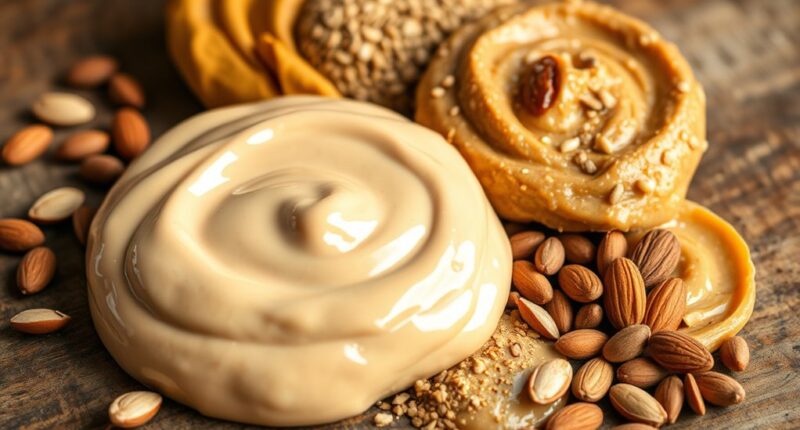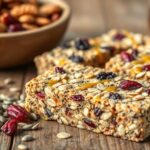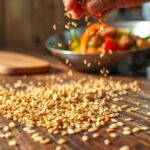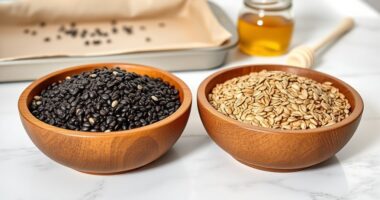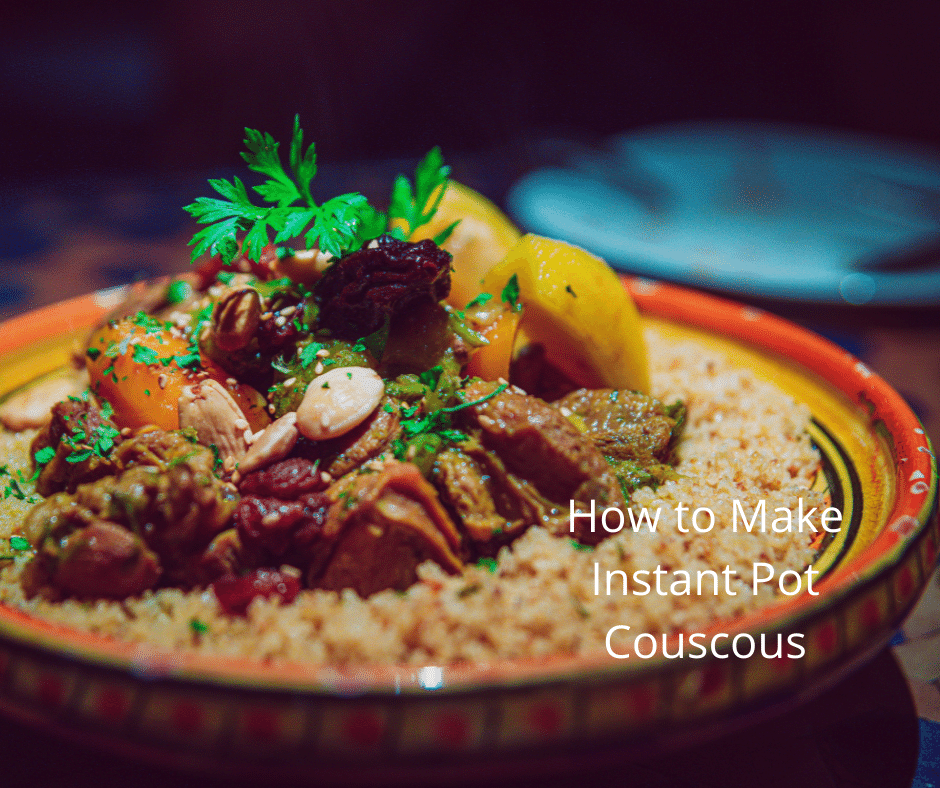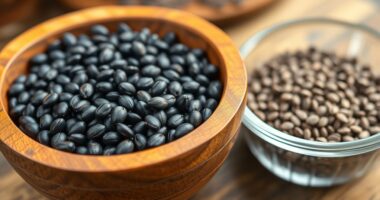Explore the top 5 seed butter recipes like classic tahini, sunflower seed butter, pumpkin seed butter, sesame seed butter, and flaxseed butter. You can make these at home by roasting seeds, blending until smooth, and customizing with flavors like honey or sea salt. Homemade seed butters offer fresh, wholesome nutrition without added preservatives. If you keep exploring, you’ll discover simple tips to perfect your own unique spreads and maximize their health benefits.
Key Takeaways
- Classic tahini: Toasted sesame seeds blended into a smooth, creamy butter, perfect for dressings and dips.
- Sunflower seed butter: Roasted sunflower seeds processed until silky, a nut-free alternative rich in healthy fats.
- Pumpkin seed butter: Toasted pumpkin seeds blended with a touch of salt for a savory, nutrient-dense spread.
- Flaxseed butter: Ground flaxseeds combined with a neutral oil, offering omega-3s and fiber in a creamy form.
- Hemp seed butter: Raw hemp seeds processed into a protein-packed, nutty-tasting seed butter ideal for smoothies and spreads.
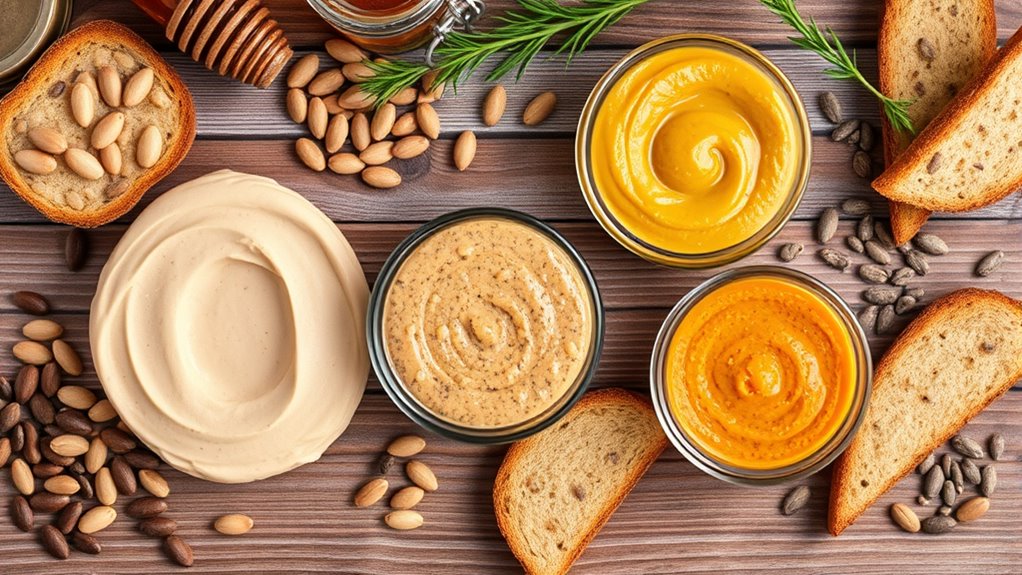
Have you ever wondered how to make delicious, nutritious seed butters at home? Crafting your own seed butters is not only satisfying but also a smart way to *guarantee* you’re getting fresh, wholesome ingredients. Seed butters like tahini, sunflower seed butter, and others pack impressive nutritional benefits, offering healthy fats, plant-based protein, vitamins, and minerals that support your overall health. Making them at home gives you control over the ingredients, allowing you to avoid added sugars and preservatives often found in store-bought varieties. Plus, once you master the basics, you can customize flavors to suit your preferences, adding a touch of honey, cinnamon, or sea salt.
Discover how to make fresh, nutritious seed butters at home for healthier, customizable spreads.
Before diving into the recipes, it’s important to understand proper storage tips. Homemade seed butters tend to have a shorter shelf life than commercial options because they lack preservatives. To keep them fresh, store your seed butters in airtight containers, preferably glass jars with tight-fitting lids. Keep them in a cool, dark place like your pantry, and if you plan to store them for more than a couple of weeks, consider refrigerating. Refrigeration not only prolongs freshness but also helps prevent the natural oils from going rancid. However, chilling can make the butter thicker, so you might want to let it sit at room temperature for a few minutes before using. If you notice any off smell or mold, discard the batch immediately to avoid health risks.
When making seed butters, start with high-quality seeds—raw and unsalted for the best nutritional benefits. Toasting the seeds lightly can enhance flavor and make blending easier, but be careful not to overdo it, as excessive heat can diminish some nutrients. Once toasted, transfer the seeds to a food processor, and blend until they break down into a crumbly texture. Continue processing, scraping down the sides as needed, until the mixture transforms into a smooth, creamy butter. Depending on your preference, you can add a pinch of salt, a drizzle of honey, or a splash of oil to improve texture and taste. Store your homemade seed butter in a clean jar, seal tightly, and enjoy it on toast, in smoothies, or as a dip.
Making seed butters at home is simple and rewarding. With the right techniques and storage tips, you’ll enjoy fresh, nutritious spreads that suit your taste while maximizing their health benefits.
Frequently Asked Questions
How Long Can Seed Butters Be Stored Safely?
You can typically store seed butters for about 1 to 3 months in the pantry or up to 6 months in the refrigerator. Keep an eye out for spoilage signs like sour smell, mold, or changes in texture. Proper storage in an airtight container helps extend their shelf life. If you’re unsure, it’s safest to discard it once you notice any off smells or visible spoilage signs.
Are Seed Butters Suitable for People With Nut Allergies?
If you have a nut allergy, seed butters can be a good alternative, but you should check for nut allergy considerations. Not all seed butters are completely nut-free, as cross-contamination can occur during processing. Always read labels carefully and choose seed butter alternatives that are specifically labeled nut-free. This way, you can enjoy a nutritious spread without risking an allergic reaction.
Can Seed Butters Be Used in Baking Recipes?
You can definitely use seed butter in baking recipes, and it adds a unique flavor that enhances baked goods. Its rich seed butter flavor works well in cookies, muffins, and bread, and it can often be substituted for nut butters. Just remember to adjust your baking techniques slightly, like reducing moisture or adding a little extra sweetener, to guarantee the best results with seed butters.
What Is the Best Way to Prevent Seed Butter Separation?
Think of seed butter separation like a dance, with oil trying to drift away from solids. To prevent oil separation, you should use proper storage techniques—keep the jar in a cool, consistent spot and stir before use. Mixing in a bit of oil when it’s too thick can also help. Regularly stirring your seed butter keeps the dance balanced, ensuring it stays smooth and ready for your favorite recipes.
Are There Any Health Benefits Unique to Seed Butters?
Seed butters offer unique health benefits you might not find elsewhere. They provide notable nutritional advantages, such as healthy fats, protein, and fiber, supporting your overall wellness. Additionally, seed butters contain unique antioxidants that help combat oxidative stress and inflammation. Incorporating varieties like tahini or sunflower butter into your diet boosts your intake of these beneficial compounds, making your meals both delicious and nutritious.
Conclusion
Now that you’ve got these top seed butter recipes in your arsenal, your snack game will explode to legendary proportions. Imagine spreading velvety tahini or sunflower butter on everything, turning plain toast into a gourmet masterpiece, and impressing everyone with your nut-free, super-nutrition-packed creations. These recipes are so delicious, they’ll make your taste buds do backflips! Get ready to transform every bite into a flavor explosion that’ll leave everyone wondering if you’ve revealed the secret to perfect seed butters.
